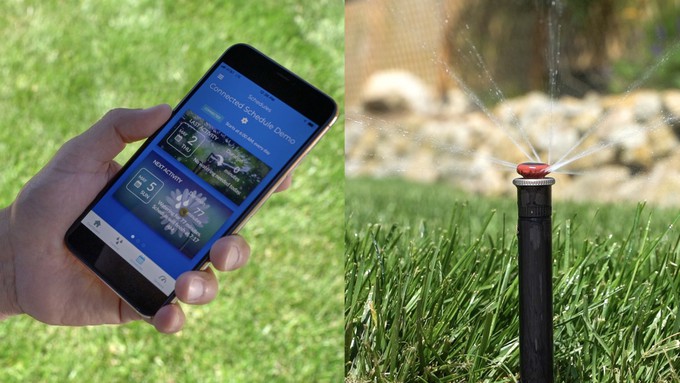
Green Acres watering seminars cover drip conversions, technology upgrades and more

Smart irrigation controllers can be controlled via an app on your phone. Water-efficient rotary nozzles put water where it's needed with little or no run-off. Photo courtesy BeWaterSmart.info
How much water do tomatoes really need? When is the best time to irrigate? (And why is watering so complicated?)
We all have water-related questions and it’s no wonder. Irrigation ranks right up there among the most confusing topics for gardeners. Yet proper watering is one of the major keys to gardening success. Conversion from traditional sprinklers to drip irrigation can save thousands of gallons annually (and a lot of cash, too). So can the installation of a smart irrigation controller or water-efficient rotary nozzles, two upgrades that can be easily done with no special tools.
Learn how to get the most out of your irrigation system during free workshops on Saturday, July 8, at all locations of Green Acres Nursery & Supply.
At 10 a.m. July 8, every Green Acres will host “Irrigation 101: Water Efficiency,” an information-packed seminar that simplifies this essential topic. Green Acres irrigation experts will walk participants through the steps of retrofitting sprinklers and upgrading technology. They’ll also answer questions about specific circumstances.
In addition, find out about available rebates that can help pay for your garden’s irrigation upgrades. Green Acres stocks many of these irrigation components, and staff will help participants pick out the right parts for their irrigation needs.
Green Acres nurseries are located in Sacramento, Auburn, Citrus Heights, Elk Grove, Folsom, Rocklin and Roseville.
For more details and directions: https://idiggreenacres.com/.
Comments
0 comments have been posted.Sacramento Digs Gardening to your inbox.
Food in My Back Yard Series
April 22: Should you stock up on fertilizer? (Yes!)
April 15: Grow culinary herbs in containers
April 8: When to plant summer vegetables
April 1: Don't be fooled by these garden myths
March 25: Fertilizer tips: How to 'feed' your vegetables for healthy growth
March 18: Time to give vegetable seedlings some more space
March 11: Ways to win the fight against weeds
March 4: Potatoes from the garden
Feb. 25: Plant a fruit tree now -- for later
Feb. 18: How to squeeze more food into less space
Feb. 11: When to plant? Consider staggering your transplants
Feb. 4: Starting in seed starting
Sites We Like
Garden Checklist for week of April 27
Once the clouds clear, get to work. Spring growth is in high gear.
* Set out tomato, pepper and eggplant transplants.
* From seed, plant beans, beets, cantaloupes, carrots, corn, cucumbers, melons, pumpkins, radishes and squash. Plant onion sets.
* In the flower garden, plant seeds for asters, cosmos, celosia, marigolds, salvia, sunflowers and zinnias. Transplant petunias, zinnias, geraniums and other summer bloomers.
* Plant perennials and dahlia tubers for summer bloom. Late April is about the last chance to plant summer bulbs, such as gladiolus and tuberous begonias.
* Transplant lettuce and cabbage seedlings.
* Weed, weed, weed! Don’t let unwanted plants go to seed.
* April is the last chance to plant citrus trees such as dwarf orange, lemon and kumquat. These trees also look good in landscaping and provide fresh fruit in winter.
* Feed citrus trees with a low dose of balanced fertilizer (such as 10-10-10) during bloom to help set fruit. Keep an eye out for ants.
* Apply slow-release fertilizer to the lawn.
* Thoroughly clean debris from the bottom of outdoor ponds or fountains.
* Start thinning fruit that's formed on apple and stone fruit trees -- you'll get larger fruit at harvest (and avoid limb breakage) if some is thinned now. The UC recommendation is to thin fruit when it is about 3/4 of an inch in diameter. Peaches and nectarines should be thinned to about 6 inches apart; smaller fruit such as plums and pluots can be about 4 inches apart. Apricots can be left at 3 inches apart. Apples and pears should be thinned to one fruit per cluster of flowers, 6 to 8 inches apart.
* Azaleas and camellias looking a little yellow? If leaves are turning yellow between the veins, give them a boost with chelated iron.
* Trim dead flowers but not leaves from spring-flowering bulbs such as daffodils and tulips. Those leaves gather energy to create next year's flowers. Also, give the bulbs a fertilizer boost after bloom.
* Pinch chrysanthemums back to 12 inches for fall flowers. Cut old stems to the ground.
* Mulch around plants to conserve moisture and control weeds.